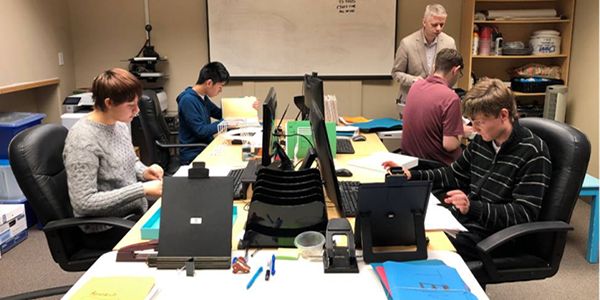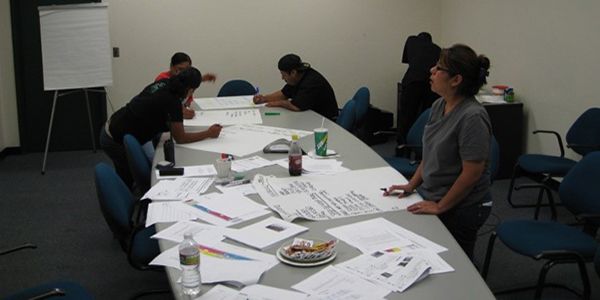From the Sponsor’s Desk – The Power of Perseverance
“It’s not that I’m so smart, it’s just that I stay with problems longer”– Albert Einstein
Most of us live busy lives, even during this nasty pandemic. Coping with the demands of the job, family and friends and keeping up with the latest dictates of our governments and public health officials can be exhausting. That can make it difficult to keep one’s focus on priorities, on what matters most.
Yet, that’s exactly what’s needed, especially in these trying times. Sustained focus allows us to move forward, to make progress on the things that matter most, to achieve our personal and professional goals. That theme is the basis for the following story, demonstrating the power of perseverance.
The Situation
Jason Harder started his career as a Registered Respiratory Therapist. Today he is the Chief Executive Officer of PFM Scheduling Services, an already profitable recent start-up. That journey demonstrates the enormous power of perseverance.
Jason prospered in the health care setting, taking on ever more senior positions and expanding his knowledge and skills along the way, including Certified Professional in Health Care Quality and Certified Pulmonary Function Technologist. When he was asked to participate in a project, he sought to improve his project management knowledge and earned his PMP designation in the process. When he became involved in a corporate reorganization, he researched the applicable practices and earned his Lean Six Sigma Black Belt and Change Management certification along the way.
In 2008, Jason joined the Alberta Innovates Centre for Machine Learning (AICML) as a project manager with a focus on the health care sector. AICML was a research lab in the Computer Science Department at the University of Alberta and is now known as the Alberta Machine Intelligence Institute (Amii). In 2009, the AICML shifted its focus to perform world class research and also to transition its inventions to deliver commercial outcomes.
During one of his engagements, the COO of the Alberta Health Services (AHS) expressed the need for an automated solution to schedule its many staff and facilities in accordance with labour contract provisions, corporate policies and budgets and government regulations. When the COO asked Jason if there was anything on the market to solve his problem, Jason replied no. When the COO asked Jason if he could build a solution, an opportunity was born.
The Goal
To develop a powerful, easy to learn and use automated scheduling solution that could support hundreds of rules from employment contracts, organizational requirements and government regulations and provide compliance analysis and metrics for the client. The solution was to be delivered in stages and to be completed in two years.
The Project
The Scheduling project started out in January 2014 as an AICML initiative with funding provided by Alberta Innovation Technology Futures (AITF). The initial team included two principal investigators, (Computer Science professors from the University of Alberta), five PhD Students with Jason as Project Lead as well as founder, inventor, designer and QA. In addition, he created the technical specifications for each module right from the start. AHS was also actively involved from the beginning. The team’s mandate: to conceptualize and experiment to see if a solution was possible.
After six months of work, the team concluded that a viable solution was achievable and the team composition changed to one principal investigator, two PhD students, two commercial programmers with Jason still as Project Lead and jack-of-all-trades. The design developed during this initial stage included four dimensions: number of Positions, Position shift assignments, FTE assignments for each position and staffing levels per shift per day. Within this construct, algorithms and algorithmic matrices were designed to contend with rule, budget, and best practice data stream sets. Four product suite modules were envisioned: solver, checker (compliance), optimizer, and analytics including a customizable array of metrics for the clients.
From that effort, work proceeded on developing the graphical user interface (GUI), a key success factor for the project. An external contractor with extensive experience in GUI development was hired and provided with specific requirements for the user interface. Unfortunately, the worked lagged. The contractor was not meeting targets and when it did produce deliverables, they did not meet the specifications. After six months the contract was terminated.
Jason then partnered with another technology provider that had a key piece of GUI that was needed and hired a senior programmer to work with the provider to develop that component. As the PhD students were moving on, two Master’s students in Computing Science and a PhD in Computing Science were added to round out the team and provide the skill sets needed to continue with development.
[widget id=”custom_html-68″]
Jason specified GUI requirements by first defining the product layers that were necessary (i.e. administration layer, business layer, analytics layer). He then spent hours with a group of schedule builders at AHS to understand the process flow to ensure that the approach was intuitive for the user. Once he understood the voice of the customer, he designed the GUI layout to mimic what he heard. The team also partnered with several schedule builders to confirm customer needs and ensure that the user experience was intuitive and friendly. As the GUI was developed, incremental testing and feedback was provided by key members of the scheduling builder group. After eighteen months, a GUI was in place and ready to go.
Concurrent to the GUI development, work progressed on building the core of the Software as a Service (SaaS) solution and the necessary administrative functions. The stack leveraged Angular, part of the JavaScript ecosystem, for building the applications, along with Java Script, Mongo Db, Ruby on Rails and C#. The team used Couch DB to structure the database and developed proprietary algorithms and algorithmic matrices to contend with the hundreds of rules and various best practices. The development approach was purposeful ensure a flexible architecture that could meet the unique requirements of individual clients and translate well into other industry verticals.
But it wasn’t all a bed of roses. During this period, the project lost its development partner and funding was becoming scarce. Jason went months without a paycheck. But the team continued with the work on the product roadmap. They also collaborated with various domain experts Jason had encountered on the journey including a health system in Texas. He also drew on his international experience as a workforce management consultant and leveraged those learnings to give continuous direction to the development of the product. And, during the course of this effort, Jason also earned a certification in Agile Software Development.
Finally, with all the parts in place, the application was able to produce a schedule that met the set completion criteria, producing a critiqued plan over 24 weeks for 100 positions. That was in March, 2017. I expect you probably heard the noise from that celebration wherever you were.
The Results
PFM Scheduling Services was incorporated in 2016. The company featured the PFM Scheduler product suite and complimentary processes and services. They earned a five year contract with AHS to Schedule /Compliance check 65,000 employees. They also signed a five year contract with the United Nurses of Alberta (UNA). UNA uses PFM only to check rotations for compliance to collective agreement rules and have checked hundreds of schedules to date. The fact that AHS and UNA use the same tool that yields a consistent interpretation of the rules helps with communication between the union and employer
On top of the tool’s success, Jason was nominated for E & Y’s Entrepreneur of the Year award for 2019. And what, you might ask, does PFM stand for? Personnel and Fiscal Management of course. What a wonderful example of the power of perseverance!
How Great Leaders Delivered
This project was a road trip to remember. Some sections were tortuous and winding, some fast downhill straights. There were any number of hidden intersections and dead end cul-de-sacs. Changes in team members and team makeup, funding challenges, the involvement of many partners, some difficult some enlightening, and the pursuit of the elusive scheduling goal were all dealt with effectively in the end. How did Jason and his team do it? Here are some of the primary contributors:
- Share the vision – Jason started out with a vision sparked by the AHS COO’s question. As that vision evolved and expanded, it became the force multiplier that kept the team on course through highs and lows, thick and thin.
- Build a high performance team – When I asked Jason to list the lessons learned over the course of the project, four of the eight items he provided dealt with his team: leverage top talent, celebrating as a team, giving specific credit to team members when engaging with clients and mentoring and developing the team. His approach yielded amazing results.
- Know you clients – From his relationship with the AHS COO to the work with the hospital’s and union’s scheduling teams, Jason ensured that his clients felt they were significant and valuable members of the PFM team. The knowledge they contributed made success possible.
- Share with your partners – Jason’s outreach to his partners, for funding, for GUI expertise, for design insight and execution, for technological support, etc. provided an expanded frame of reference and a huge return in terms of product quality and capability.
- Prove the concept – You’ll notice that there was no rush to market as soon as the need was identified. There was a proof of concept stage followed by GUI prototyping and development concurrent with core function work. The initial release included the Solver component only. The approach was deliberate. The focus was on priority, quality and client need.
- Be creative with funding – Finding parties to bankroll an endeavor like the PFM Scheduling Suite can be a challenge. Jason was able to leverage government, commercial and private equity investors over the course of the project to keep the ball rolling. I expect he would only recommend going without a pay cheque as an option of last resort.
- Use technology as an enabler – One might look at the PFM Scheduling Suite of products as primarily a technology solution. And that could not be further from the truth. This project was first and foremost a business project, involving changes in business processes, functions and rules. In fact, the company, PFM Scheduling Services, offers a six step consulting service to help its clients maximize the tool’s value. The technology that was selected to develop and operate the SaaS solution was chosen because it enhanced business value.
- See obstacles as opportunities – There were numerous bumps in the road on this project journey. Any one of them could have been reason enough for Jason to throw up his hands and concede defeat. Instead, every obstacle became an opportunity to learn more, consider other options and do things differently. To stay with it.
- Learn – Jason’s penchant for picking up certifications along the way imbued the team with a learning mindset as well. It became a problem solving learning machine.
So, if you’re involved in a challenging project with an uncertain future, consider what Jason and his team did to achieve a successful outcome. It worked for them. It can work for you and your team as well. And remember the power of perseverance. Also, make sure you use Project Pre-Check’s three building blocks covering the key stakeholder group, the decision management process and the Decision Framework right up front so you don’t overlook these key success factors.
Finally, thanks to everyone who has willingly shared their experiences for presentation in this blog. Everyone benefits. First time contributors get a copy of one of my books. Readers get insights they can apply to their own unique circumstances. So, if you have a project experience, a favorite best practice, or an interesting insight that can make a PM or change manager’s life easier, send me the details and we’ll chat. I’ll write it up and, when you’re happy with the results, Project Times will post it so others can learn from your insights.










